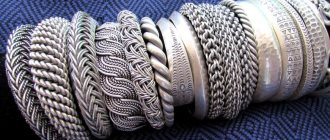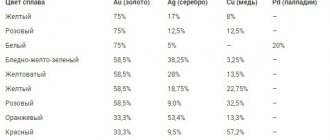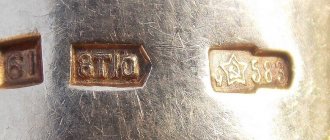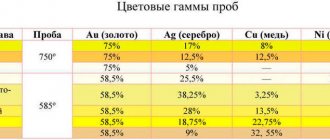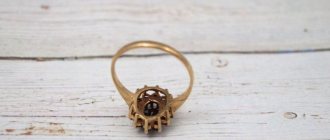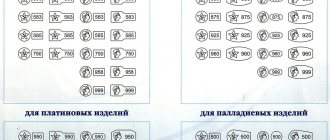Gold is a strong, wear-resistant metal with an incredibly beautiful appearance. The limited nature of its reserves creates a high cost of the metal, which tends to constantly increase. Many people are ready to invest their savings in the purchase of gold and products made from it, since such an investment has always been, is and will be profitable. But how can one not be mistaken about the authenticity of a metal and understand the systems for assessing it? For this purpose, the metric gold standard system and the carat system were developed.
Composition of gold alloys
In addition to gold, jewelry alloys contain a ligature, which can consist of:
- platinum (increases elasticity, discolors gold, increases melting point);
- silver (increases ductility, makes the alloy more malleable and easier to process, gives a white tint);
- palladium (brightens, imparts plasticity, increases the melting point);
- nickel (gives hardness, “whitens”, increases resistance to corrosion, but can cause an allergic reaction);
- cadmium (thanks to it, the alloy melts easier, it also gives a greenish tint);
- copper (increases hardness, gives a reddish tint, reduces anti-corrosion properties);
- zinc (improves the fluidity of the metal, reduces the melting point, can give a greenish tint).
These additives increase the consumer properties of the alloy - making it stronger, more durable, and resistant to wear. The hallmark designation in numbers is applied to each piece of jewelry, as required by the legislation of the Russian Federation (all products made from alloys containing more than 30% precious metal must be stamped).
Who tests?
In Russia, the gold marking process is regulated by the State Assay Office under the Ministry of Finance. It is this state assay supervision body that carries out analysis, testing, and hallmarking of gold products.
A hallmark on a piece of jewelry is a guarantee that it is truly made from the appropriate precious alloy. If the sample is missing, looks fuzzy or suspicious, then you may have a fake. You can check the sample of the product at the assay office.
Where is gold usually sampled? Most often - on the inner surface of a ring, on a link in earrings, on a link near a lock in chains and bracelets. To preserve the aesthetic appearance of the decoration, the markings are made miniature.
Sample systems: metric, carat, spool
The numerical designation of the sample is applied to all jewelry, but not all jewelry is marked according to a single system. Today, two sample systems are used - metric and carat, but in the last century in Russia the spool system was used.
Metric
Used in most countries of the world. The highest standard of the system is 1000th. For example, a 750 gold alloy contains 75% gold, the remaining 25% comes from other metals.
It is difficult to achieve the exact content of precious metal in an alloy, so GOST sets a remedium of 3 units for alloys containing gold, silver, and copper. That is, a gold alloy of 375 purity of gold should contain from 372 to 378 units (a deviation of 3 units in both directions is allowed). If the material contains nickel, then the remedium is 5 units. For an alloy of 585 standard, only a positive remedium of 5 units applies - deviations are allowed upward, but not downward.
Carat
Currently used in some European countries and the USA. The highest standard of the system is 24. Samples of 9, 14, 18, 22 are used - they show the content of pure precious metal in the composition. For example, 18 karat gold means that 18 of 24 parts are pure gold (this corresponds to 750 fine gold in the metric system). 1 carat in this system is equal to 9.744 grams.
Zolotnikovaya
Spool samples are old gold samples; they are no longer used. This system was used in Russia until 1927. The highest standard is 96. The units of measurement are:
- 1 pood = 40 pounds = 16.380 kilograms.
- 1 pound = 96 spools = 409.512 grams.
- 1 spool = 4.266 grams = 96 shares.
- 1 share = 0.044 grams.
For marking jewelry, samples of 56, 72, 92, 94 were used. If a sample of 56 was indicated, this meant that 1 pound (96 spools) of such an alloy contained 56 spools of pure gold (this corresponds to 585 samples of the metric system).
What is a carat?
So, there is an international treaty called the Meter Convention, which has now been signed by 55 industrialized and trading nations. This agreement ensures the constancy and unity of measurement standards, including the carat, as a unit of measurement for the mass of a precious stone or pearl.
♥ ON THE TOPIC: BelAZ-75710: 1,300 liters of fuel per 100 km and other 7 facts about the best dump truck in the world from Belarus.
What types of gold exist?
You can find out what standard of gold the jewelry is made from by the markings that must be applied to each product. In jewelry, the following gold samples are used: 375, 583, 585, 750, 958. In some countries, another standard is used to create jewelry - 333 (such an alloy quickly oxidizes). This is not an exhaustive list - GOST 6835-85 mentions 18 different samples and 40 gold alloys.
Sample 375
Composition: 37.5% gold, 62.5% silver and copper.
- Used for making chains, earrings, bracelets, pendants, wedding rings.
- Due to its low price and durability, it was widely used in the Soviet Union for the manufacture of “gold” wristwatches and wedding rings.
Depending on the percentage of copper and silver, the alloy can range in color from yellow to deep red (more copper means more red). Sometimes palladium is added to the composition (with 40% palladium and 10% silver, a very delicate creamy shade is obtained). The material is durable, strong, but is susceptible to oxidation, which is why it loses its attractiveness and becomes grayish when polishing is lost. Jewelers jokingly call this sample “an alloy of copper and silver containing gold.”
Sample 583
This alloy was the gold standard of the USSR. Most of the jewelry at that time was made from this material (almost every family preserved rings or earrings of 583 standard, which were once worn by mother or grandmother). In 2000, 585 sample became the standard in Russia.
Sample 585
- Used to make wedding rings, earrings, crosses, tie clips, and church utensils.
- The alloy is durable and easy to process; various technologies can be used with it - laser welding, weaving, blowing.
Composition option 1: 58.5% gold, 33.5% copper, 8% silver.
A durable alloy with a reddish or yellow tint, easy to solder. The metal is malleable and does not tarnish in air.
Composition option 2: 58.5% gold, 41.5% nickel and palladium.
Durable alloy with a white tint, easy to solder, does not oxidize.
Sample 750
Composition option 1: 75% gold, 25% silver.
Material with this composition has a greenish tint.
Composition option 2: 75% gold, 21% copper, 4% nickel.
Reddish alloy.
Composition option 3: 75% gold, 15% silver, 10% copper.
Yellow alloy.
All three versions of the 750-grade material have excellent characteristics: they are durable, wear-resistant, and easy to solder, cast, and polish. They tolerate contact with the environment normally, but due to their increased softness they require careful and careful handling. The alloy of this sample is most often used to create frames for fragile precious stones, in the manufacture of products with filigree, as a basis for applying enamels (to prevent the enamel from tarnishing, choose a composition with a copper content of up to 16%).
Sample 958
Composition: 95.8% gold, 4.2% silver and copper.
The metal is bright yellow, malleable and soft, and was formerly used to make wedding rings. Today, domestic jewelers almost never use this high-grade alloy in their work, but products made from it are often found in Arab countries. Due to its softness, such an alloy is prone to deformation; polishing on jewelry made from it does not last long.
Sample 999
Almost pure noble metal with a negligible amount of impurities. Bank bars are made from this gold. It is not used to create jewelry due to its tendency to deform.
Diamond weight
A girl's best friend is diamonds! Cut diamonds are popular all over the world. There are many tables for determining their weight without special measuring instruments.
How to determine how much a diamond weighs if you know the size in mm
The weight of diamonds, like other cut stones, is calculated using tables. To measure them, they do not use ordinary rulers, but special ones, with divisions in fractions of millimeters.
Since often a gem does not fit exactly 2 or 4 millimeters in size, it can have a dimension of 2.1 and so on.
The type of cut is also taken into account when calculating the weight of the stone:
- For a round cut, multiply the height of the diamond by the diameter of the girdle squared and by a factor of 0.006.
- For a heart cut, the length is multiplied by height, width, length and a factor of 0.0059.
- For the pear cut, the formula is similar to the heart cut.
The coefficient changes, and it depends on the ratio of the length and width of the processed stone. To simplify counting, there are various tables that will help the owner quickly calculate the approximate weight of a diamond.
One carat diamonds
Such a diamond is considered a large stone. So, 1 carat is how many grams? 200 mg is a generally accepted value. For a processed diamond, a weight of 200 mg is considered so significant that 1 carat of diamond (price in rubles) can reach 25 million. A 1 carat diamond, the price of which is significantly lower, may turn out to be of poor quality or counterfeit.
A low quality diamond can be bought for 60,000 rubles; the better the quality, the higher the cost. Diamonds over 1 carat are considered premium stones.
The cost of a diamond can also be affected by its shade; the most popular stones are transparent, without color impurities. Do not forget that 1 carat of diamond does not guarantee the same value for all diamonds, since there are other criteria.
What is 1 carat diamond:
Diamond weight table
What is a carat of a diamond? As with other gems, this is a measure of weight. Diamond carats table:
Price per gram of gold of different samples
Of course, the higher the content of noble metal in the alloy, the higher its price. The cost of materials of different samples depends on the current price of gold; the cost of finished products is also affected by the manufacturer’s and seller’s markups.
For example, today the Central Bank of the Russian Federation has set a price of 2,740 rubles for 1 gram of gold. To find out the cost of a precious alloy of different samples, you need to multiply this price by the appropriate coefficient:
- for sample 375: 2740*0.375=1027.5 rubles per 1 gram;
- for sample 585: 2740*0.585=1602.9 rubles per 1 gram.
The price of 1 gram of jewelry will be higher, because gold has a long way to go before it appears on the display in the form of a ring or bracelet. The cost of the finished product includes the work of jewelers, the cost of paying workers, losses on rejection, associated costs of the jewelry enterprise, and the store’s markup.
Obsolete carat
In the literature and scientific works of the past, you can also find the designations “English carat” and “Arabic carat” (also known as “Kirat”).
The English carat (about 205.4 grams) was used in Britain and its colonies until 1888 and was equal to approximately 3,170 troy grains, which in turn was equivalent to the weight of an average grain of barley.
The Arabic carat was defined differently in different countries of the Middle East and Asia. For example, in Egypt and Syria it was about 195 mg, and in Asia Minor - 204 mg.
♥ ON THE TOPIC: 70 interesting facts about IT technologies that you might not know.
How to determine gold purity by the color of the alloy
The color of pure gold is bright yellow, but due to its softness, this metal in its pure form is not used to create jewelry. Jewelry is made from gold alloys, in which only part of the composition is allocated to gold. Ligatures (additives) make the connection harder, stronger, and give it different shades.
Based on the shade of the alloy from which the product is made, one can assume its sample. But this method of determining the composition is imperfect; only examination can accurately determine the percentage of gold and other metals.
Pink
This shade is characteristic of alloys containing silver and copper, in particular the following samples:
- 375: dark pink,
- 585: soft pink;
- 750: slightly pinkish.
White
If you see a piece of jewelry with a white tint, most likely it is 750-grade metal. 25% of the composition is occupied by silver and palladium or silver and nickel.
Green
- Dark green color is typical for 750 standard with the following composition: 75% gold, 15% silver, 6% copper, 4% cadmium.
- The pale green material is obtained when 23% copper and 2% cadmium are added to 75% gold.
- The yellow-green metal is most likely 750 fine, and 25% of the composition is silver.
Violet
Gold jewelry may have a purple tint if it is made from a 14-karat alloy that contains 25% aluminum or potassium. If the color is rather bluish, then with a high probability it is a composition of 46% noble metal and 54% rhodium, cobalt or indium.



